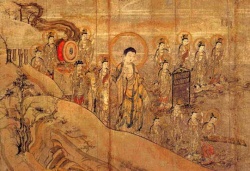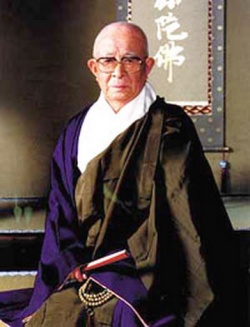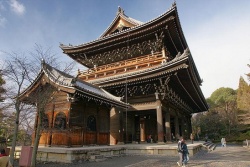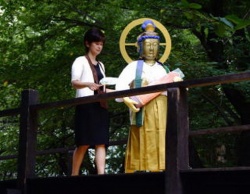Jōdo-shū
Jōdo-shū (浄土宗?, "The Pure land School"), also known as Jōdo Buddhism, is a branch of Pure Land Buddhism derived from the teachings of the Japanese ex-Tendai Monk Hōnen. It was established in 1175 and is the most widely practiced branch of Buddhism in Japan, along with Jōdo Shinshū.
History
The Founder: Hōnen
Hōnen was born in 1133, the son of a prominent family in Japan whose ancestry could be traced back to silk merchants from China. Hōnen was originally named Seishi-maru after the Bodhisattva Seishi (Mahasthamaprapta in Sanskrit). After a rival official assassinated his father in 1141, Hōnen was initiated into his uncle's Monastery at the age of 9. From then on, Hōnen lived his Life as a Monk, and eventually studied at the famous Monastery of Mount Hiei.
Hōnen was well respected for his Knowledge and for his adherence to The Five Precepts, but in time, Hōnen became dissatisfied with the Tendai Buddhist teachings he learned at Mount Hiei. Influenced by the writings of Shan-tao, Hōnen devoted himself solely to Amitābha (Amida) Buddha, as expressed through the Nembutsu.
In time, Hōnen gathered disciples from all walks of Life, and developed a large following, notably women, who had been excluded from serious Buddhist practice up to this point. This included fishermen, prostitutes and Fortune tellers. Hōnen also distinguished himself by not discriminating against women who were menstruating, who were Thought at the time to be unclean. All of this caused concern among the religious and political elite of Kyoto and eventually the emperor Gotoba issued a decree in 1207 to have Hōnen exiled to a remote part of Japan, and given a criminal's name. Some of Hōnen's followers were executed, while others, including Bencho, Ryukan and Shinran, were exiled to other regions of Japan away from Hōnen.
Eventually, Hōnen was pardoned and returned to Kyoto in 1211, but died soon after in 1212, just two days after Writing his famous One-Sheet Document.
After Honen
Because Honen and his disciples were largely exiled to remote provinces, and due to differences in background and monastic training, the teachings began to take on regional differences. Some sub-sects died out quickly, while others survive through the modern era. The main branch of Jodo Shu started under Honen's Disciple Benchō who was exiled to Chinzei on the island of Kyushu. There, Bencho actively preached Honen's Doctrine while refuting what he considered deviations taught by other disciples (particularly Kosai's controversial "once-calling" teaching).
Another Monk named Ryōchū became his Disciple for a year, and then spread Bencho's and Honen's teachings throughout Japan before reaching the capital at Kamakura. Ryōchū helped to legitimize the "Chinzei branch" of Jodo Shu as the mainstream one, and is credited as the 3rd Patriarch accordingly. He also referred to Bencho his teacher as the 2nd Patriarch after Honen. Ryōchū also met with Renjaku-bo, whose own teacher Genchi, had been another Disciple of Honen. Renjaku-bo felt that Genchi and Bencho had been in complete agreement, so he willingly united his lineage with Ryōchū's, helping to further increase its standing.
Jodo Shu through the Chinzei lineage continued to develop until the 8th Patriarch, Shōgei (聖冏, 1341 - 1420) who formalized the training of priests (rather than training under Tendai or Shingon lineages), thus formally establishing it as an independent sect.
Doctrine
Jōdo-shū is heavily influenced by the idea of Mappō or The Age of Dharma Decline. The concept of Mappō is that over time society becomes so corrupt, that people can no longer effectively put the teachings of The Buddha into practice anymore. In medieval Thought, signs of Mappō included warfare, natural disasters and corruption of The Sangha. The Jōdo-shū school was founded near the end of the Heian Period when Buddhism in Japan had become deeply involved in political schemes, and some in Japan saw Monks flaunting Wealth and Power. At the end of the Heian Period warfare also broke out between competing samurai clans, while people suffered from earthquakes and series of famines.
Hōnen, through Jōdo-shū teachings, sought to provide people a simple Buddhist practice in a degenerate age, that anybody could use toward Enlightenment: Devotion to Amitābha Buddha as expressed in the Nembutsu. Through Amitābha's Compassion, a being may be reborn in the Pure land (Sukhavati in Sanskrit), where they can pursue Enlightenment more readily. Hōnen did not believe that other Buddhist practices were wrong, but rather, they were not practical on a wide-scale, especially during the difficult times of the late Heian Period.
Repetition of the Nembutsu is the most fundamental practice of Jōdo-shū, which derives from the Primal Vow of Amitābha Buddha. In home practice, or in temple liturgy, the Nembutsu may be recited in any number of styles including:
- Jūnen (十念?, "Ten Recitations") - reciting the Nembutsu ten times, with the last drawn out.
- Nembutsu Ichie (念仏一会?, "Nembutsu Gathering") - reciting the Nembutsu as many times as possible in a sitting, regardless of number.
- Nembutsu Sanshōrai (念仏三唱礼?, "Three Intonations of Praise") - a style involving three drawn-out recitations of the Nembutsu, follow by a bow. This is repeated twice more for a total of 9 recitations.
However, in addition to this, practitioners are encouraged to engage in "auxiliary" practices, such as observing The Five Precepts, Meditation, the Chanting of Sutras and other good conduct. There is no strict rule on this however, as Jōdo-shū stresses that the Compassion of Amitābha is extended to all beings who recite the Nembutsu, so how one observes auxiliary practices is left to the individual to decide.
The Larger Sutra of Immeasurable Life is the central Buddhist scripture for Jōdo-shū Buddhism, and the foundation of the belief in the Primal Vow of Amitābha. In addition to the Larger Sutra, the Contemplation Sutra and the Amitabha Sutra (The Smaller Sutra of Immeasurable Life) are important to the Jōdo-shū school. The writings of Hōnen, contained mostly in the Senjaku-hongan-Nembutsu-shū (often abbreviated to 'Senchaku-shū'), are another source for Jōdo-shū Thought as is his last Writing, the Ichimai-Kishōmon (一枚起請文?, "One-Sheet Document"). Most of what is known about Honen and his Thought is attributed through sayings collected in the follow century, the Senchakushū, and letters to his students and disciples.
Jōdo-shū, like other Buddhist schools, maintains a professional, monastic priesthood, who help to lead the congregation, and also maintain the well-known temples such as Chion-in. The head of the Jōdo-shū school is called the monshu in Japanese, and lives at the head temple in Kyoto, Japan, Chion-in Temple.
Sub-sects
The main 'Chinzei' branch of Jodo Shu was maintained by the so-called "Second Patriarch" and Disciple of Honen, Shoko, also known as ’’Benchō. However, other disciples of Hōnen branched off into a number of other sects and interpretations of Jodo Shu Thought, particularly after they were exiled in 1207:
- Shoku founded the Seizan branch of Jodo Shu, which structured the Buddhist teachings into a hierarchy with the Nembutsu at the top. Because Shoku's teachings were compatible with the dominant Tendai sect, Shoku was not exiled.
- Ryukan, one of Honen's more elderly disciples, emphasized the efficacy of the Nembutsu as practice, and encouraged its frequent recitation, leading to his teachings being called the "many callings school" or tanen-gi (多念義). He was exiled to eastern Japan where he died en route.
- Kōsai taught the idea that a single recitation of the Nembutsu was all that was necessary. His Doctrine of "once-calling" or ichinen-gi (一念義) provided considerable controversy, and Honen eventually disavowed Kōsai and his teachings. He was later exiled to the island of Shikoku.
- Chosai, the last of Hōnen's direct disciples, felt that all practices in Buddhism would lead to birth in the Pure land.
- Awanosuke, the Fortune-teller. He is credited with the double-stranded rosary, or juzu used in Jodo Shu sects, though he did not establish a branch of his own.
Another Disciple, Shinran founded the Jōdo Shinshū sect of Buddhism, which diverges somewhat doctrinally, but otherwise is heavily influenced by Hōnen and his teachings. In Jōdo Shinshū, Hōnen is considered the Seventh Patriarch. Depending on the viewpoint, Shinran and Jōdo Shinshū are considered another branch of Jodo Shu.
Geographic distribution
Although Jōdo-shū is mainly found in Japan, a sizable Jōdo-shū community exists in Hawaii as well as a few temples in the continental United States.
Source
In Japan, Pure Land Buddhism was established, as a sect, in 1175 by Honen (1133-1212), who taught that even those who had mastered Buddhist philosophy “should behave themselves like simpleminded folk” and devote themselves in practicing the Nembutsu, recitation of the formula Namu Amida Butsu [homage to Amitabha Buddha). This concept of Honen is known as ‘Jodo Shu’.
Jodo Shu traces its history back to the moment in 1175 when the teacher Honen set up residence on Higashiyama and began his teaching career. While this is perhaps best understood as a mythical beginning for Jodo Shu, a more complicated beginning was developed by Honen’s disciples through several streams according to their own epistemology so this 1175 is the most trustworthy.
Although all of these movements consider Honen as a mentor and legendary teacher, it is only Jodo Shu which claims him as its principal teacher and which attempts to carry on his essential teaching. It was not until the early 15th century that the teachings and training system of Jodo Shu was systematized and that it gained official government approval. This was soon followed by a period of great prosperity inaugurated by the patronization of Tokugawa Ieyasu in 1590. From this prosperity to the excesses of the late Edo period and through the second world war period, Jodo Shu has proceeded to develop and change.
Today, Jodo Shu has about seven thousand temples and Chion-in, in Kyoto, is considered to be the head temple. There are seven other main temples in the country and nineteen oversea temples in Hawaii, mainland USA and Brazil. The number of Jodo Shu adherents, in japan, in 2001 was 6.5 million.
Honen came across a Chinese commentary which said, “Only repeat the name of Amitabha (Amida) with all your heart, whether walking or standing, whether sitting or lying; never cease to practice for a moment. This is the very work which unfailingly issues in salvation.” Following this statement Honen took up the practice of repeating the Nembutsu 60,000 times a day eventually increasing that to 70,000 times a day. From there on, as the heart of all rituals as practiced by the Jodo School has been Nembutsu (literally means “Buddha in mind”).
In Jodo Shu, they recite the Nembutsu at three different occasions. The first type of recitation is done in every day’s life, and is called “Jinjo Gyogi”. The second type of Nembutsu is called “Betsuji Nembutsu” which is performed only on a pre-determined date and time, according to a calendar. The third type is called “Rinju Gyogi” and chanted on one’s deathbed just before the believer is welcomed into the Pure Land (Jodo in Japanese.)
There are three different ways of reciting the . First, ‘Junen’ prescribes to recite ‘Namu Amida Butsu’ ten times. Secondly, ‘Nembutsu Ichie’ suggests reciting as many times as possible without limiting its number. Thirdly, ‘Sanshorai’ proposes to recite three times very slowly and finished with a deep bow. This is repeated three times making nine, the total number of Nembutsu.
Nembutsu is the 18th vow out of a series of 48 vows that Amitabha Buddha made in the ‘Larger Sutra of Immeasurable Life’.
The Five theories of Nembutsu are as follow:
- “Faith is a primary element in the efficacy of Nembutsu, but not an exclusive one”- Nembutsu relates the limited self and the Unlimited, the Unborn, the Deathless.
- “Contrition is a necessary preparation for Nembutsu”: Contrition is the softening of heart comes through confession that one is a foolish being of wayward passion and so is in the same plight spiritually as others. It is the foremost important pre-requisite of awakening through uttering the Nembutsu meaningfully.
- “Good work springs naturally from Nembutsu”: When one utter with the utmost belief,” I, a foolish being, ask You to act through me”, he conquers freedom from the blindness of superiority and finds pleasure in service to mankind.
- “Nembutsu is a condensed form of all of Buddha’s teaching”: Nembutsu is a concise expression of all the essence of the teachings of Buddha.
- “Nembutsu brings us into the presence of the sacred”: It abandons one’s life to Buddha and expresses a willingness to rely upon the calling from the other shore.
Besides Nembutsu, Jodo Shu encourage followers to engage in ‘auxiliary’ practices, such as observing the Five Precepts, meditation, the chanting of sutras and other good conduct.
In Tokyo, Japan, a Jodo Shu Research Institute has been established in 1989 through the integration of three separate institutes on Jodo Shu teachings: propagation and rituals which had been established 50 years earlier.
Jodo Shu followers celebrate several Ceremonies that include shusho-e, Gyoki-e, nehan-e, Chinzeiki, Zendoki, Spring season Higan-e, Founder’s Day/Honen’s Birthday (shuso-kotan-e), Buddha’s Birthday (kanbutsu-e), Segaki-e May to September, Kishuki, Urabon-e, Autumn season Higan-e, Buddha’s Enlightenment (jodo-e), Chanting of the Buddhas’ Names (butsumyo-e), Joya.
Jodo Shu allows its believers to experience deep tranquility and the silence of peace when one abandons his/her ego, reflects on how ignorant and sinful he/she was as a human being, and leave everything to the compassion of Amida Buddha, reciting Namu Amida Butsu many times.



